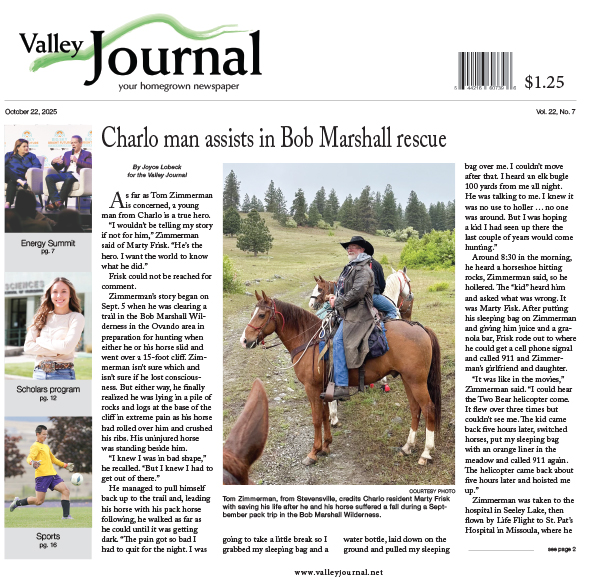Avalanche danger ‘considerable’
Hey savvy news reader! Thanks for choosing local.
You are now reading
1 of 3 free articles.
News from the Confederated Salish and Kootenai Tribes
FLATHEAD RESERVATION — This time of year, snow and cold weather are constantly changing and some-times the changes come rapidly and dramatically over a short period of time.
The avalanche danger was raised to “considerable” on all slopes in the area north of the Mission Valley. The Flathead Avalanche Center predicts avalanche danger is considerable above 5,000 feet. New snow, rain on snow, and strong winds create dangerous avalanche conditions that include wet and dry avalanches.
New snow/rain combined with weak snow surrounding a variety of crusts deeper in the snowpack makes it dangerous and tricky right now. Pay attention to rapidly changing conditions.
Human-triggered avalanches will become increasingly more likely and natural avalanches are possible.
Avalanches involving people don’t happen by accident. There are four key factors that determine avalanche danger. One, terrain: the slope must be steep enough to avalanche, generally 30 degrees or greater. Two, snow pack: the snow must be unstable enough to avalanche. Three, weather: changing weather can quickly increase instability. Four, trigger: A trigger causes additional stress to the snow pack that initiates the avalanche.
Nearly all avalanches that involve people are triggered by the victims themselves or a member of their group. This is good news because it means that if we learn to recognize the warning signs we can avoid avalanche danger.
Here is a short list of avalanche safety guidelines:
—Most avalanches start on slopes that are 30 degrees or greater. If you stay off of 30 degree (and greater) slopes and avoid traveling beneath them, your risk is greatly minimized.
—If you remember anything about avalanches remember this: avalanche danger is greatest during and shortly after intensive snowfalls and wind events. Traveling on or below 30 degree slopes during intensive storms is very dangerous. (Intensive storms are those in which one inch of snow falls per hour).
—Wind moves snow from windward to leeward slopes and can create the same kinds of unsafe conditions created by an intensive snowfall. Stay off leeward slopes during and after periods of strong winds. These instabilities can persist throughout the winter.
—Watch for the leeward pockets. Sides of gullies, steep short slopes and backsides of ridges can be areas where the wind has deposited snow. Plan your route to avoid these areas.
One extremely dangerous time in the mountains occurs when a period of cold weather is followed by a sudden warming trend or rain falling on the snow pack. Free water in the snow pack lubricates weak layers and often large avalanches result. Like intensive storms, it is a very dangerous time to be traveling in the mountains.
Dense tree cover provides some protection from avalanches, however, slopes with trees are often not as safe as people expect. One quarter of all avalanches victims die from trauma from hitting objects such as trees. Sparse trees spaced greater than 3 meters of one another do not provide any more protection than open slopes.
In the spring, big wet, damaging avalanches can occur. The safest time to travel is in the morning after a cold, clear night when the snow is frozen. Get off of steep slopes when the snow begins to soften from melting.
Outdoor recreationists should examine travel plans and current weather conditions for changes. If you are planning to travel in avalanche terrain it is wise to check the most current avalanche conditions at www.avalanche.org .
If you go to the backcountry to hike, snowshoe, ski, or snowmobile you should educate yourself about ways to reduce avalanche danger and follow these guidelines.
For more information on avalanche safety contact Germaine White at 406-883-2888.
















